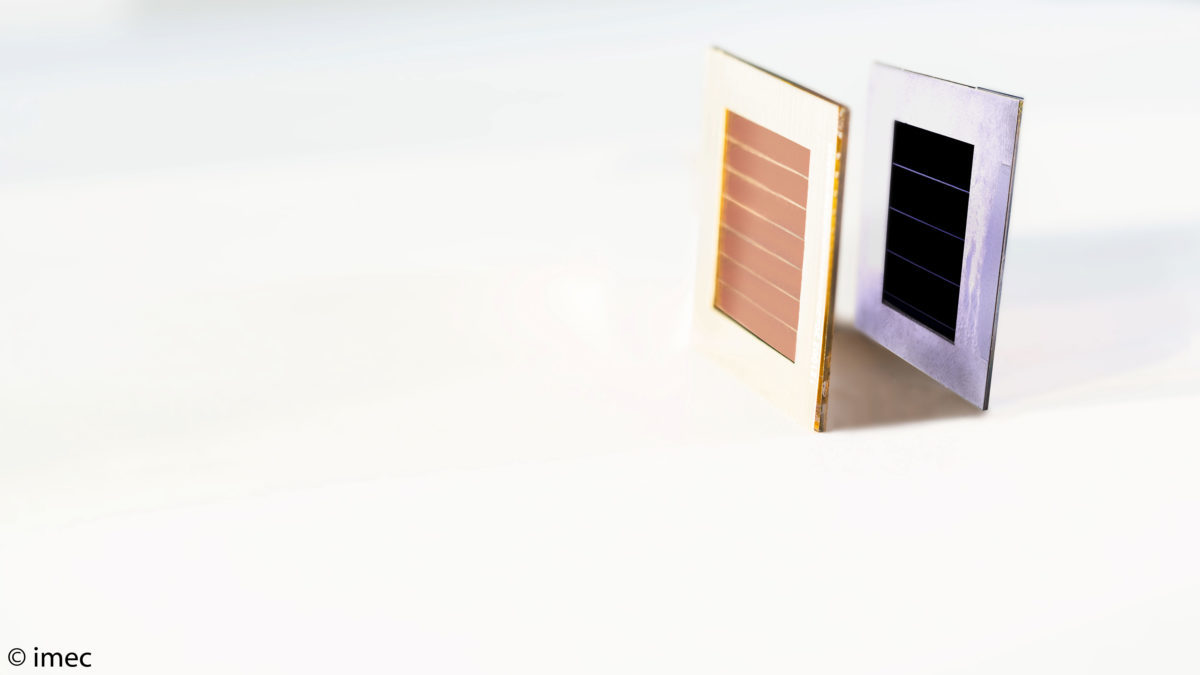From pv magazine Global
Imec has announced a new 24.6% efficiency for a tandem CIGS solar cell based on perovskite. The institute said that its perovskite cell, developed in partnership with Dutch BIPV consortium, Solliance and EnergyVille, a joint venture between the Flemish research partners KU Leuven, VITO, UHasselt and Imec, has been combined with a CIGS cell, developed by Germany’s Centre for Solar Energy and Hydrogen Research (ZSW).
The new device uses light in the visible part of the solar spectrum, while the light in the near-IR spectrum that passes through the perovskite cell is harvested by the underlying CIGS cell, Imec explained, thus enabling the 4-terminal tandem cell significantly to outperform the stand-alone perovskite and CIGS cells.
Imec explained that the record efficiency was achieved thanks to two innovations it applied: the improvement of the transmittance of the perovskite cell for near-IR light through the addition of optical coupling layers to the tandem stack and the optimization of the transparent electrodes; and the optimization of the wide bandgap of 1.72eV.
“The CIGS cell of 0.5cm² size has been made at the high-efficiency line at ZSW, employing all optimized processes necessary for the preparation of record devices,” the research institute said in its statement.
New records at EU PVSEC
At this year’s EU PVSEC, held this week in Brussels, imec also announced it had hit 23.03% efficiency with an n-type PERT (Passivated Emitter and Rear Totally diffused) cell. The efficiency has been certified by Fraunhofer ISE, and imec notes that it was achieved using a process compatible with large-scale production.
Though the industry remains more focused on p-type silicon, n-type does offer advantages, according to imec, in that it is not affected by light induced degradation – an issue, which has affected the output of many installed solar panels, and still may not be entirely solved. Philip Pieters, Business Director at imec told pv magazine that many manufacturers could use existing equipment to produce this n-type cell, eliminating the need for costly investment in new production equipment.
“Until now, nPERT solar technology has not yet found the traction it deserves in the industry,” added Loic Tous, senior researcher at imec. “With these ever-improving results, which we achieved by applying knowledge gained from our bifacial nPERT project, we are now demonstrating the potential of nPERT technology. The advantages in stability and efficiency potential over p-type PERC cells, while using the same equipment with the addition of a Boron diffusion, make this a very promising technology for future manufacturing lines.”
The research collaboration, Solliance, of which imec is a part, also published new results at the EU PVSEC conference, demonstrating a perovsite solar cell measuring 0.09 cm², which retained 93% of its performance after 3,000 hours of testing at 85°C – showing progress in one of the main areas that has held perovskite solar cells back from commercialization. The team at Solliance said it will now focus on scaling this up to develop an industrially viable process.
In July, Imec announced a 27.1% efficiency on its perovskite/silicon tandem cell. The company’s latest efficiency records are approaching that of U.K./Germany-based perovskite specialist, Oxford PV, which has hit 27.3% efficiency on a 1cm² tandem cell.
By Emiliano Bellini and Mark Hutchins
This content is protected by copyright and may not be reused. If you want to cooperate with us and would like to reuse some of our content, please contact: editors@pv-magazine.com.








By submitting this form you agree to pv magazine using your data for the purposes of publishing your comment.
Your personal data will only be disclosed or otherwise transmitted to third parties for the purposes of spam filtering or if this is necessary for technical maintenance of the website. Any other transfer to third parties will not take place unless this is justified on the basis of applicable data protection regulations or if pv magazine is legally obliged to do so.
You may revoke this consent at any time with effect for the future, in which case your personal data will be deleted immediately. Otherwise, your data will be deleted if pv magazine has processed your request or the purpose of data storage is fulfilled.
Further information on data privacy can be found in our Data Protection Policy.